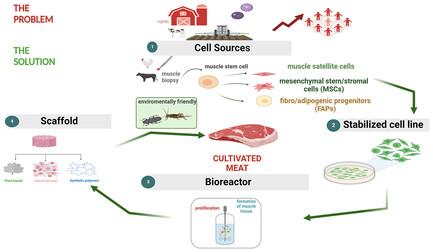未来一瞥:利用哺乳动物和昆虫细胞培养肉类
IF 11.1
Q1 MATERIALS SCIENCE, MULTIDISCIPLINARY
引用次数: 0
摘要
随着全球人口的增长和对肉类需求的增加,人们需要找到可持续和可行的方法来替代传统的生产方法。其中一种潜在的解决方案是培养肉(CM),即利用动物干细胞在体外生产肉类,生产出营养和感官特性与传统牲畜肉类相似的产品。本文探讨了当前的CM生产方法,并研究了如何利用昆虫细胞来加强这一过程。细胞来源是中药生产中的一个关键问题,同时也是培养基、生物反应器可扩展性和支架开发方面的进步。与常用的哺乳动物细胞相比,昆虫细胞在克服阻碍细胞培养发展和扩增的技术挑战方面可能具有优势。本综述旨在强调昆虫作为中药生产的细胞来源,如何提供更可持续的选择。实现这一目标的关键是全面了解肌肉和脂肪细胞的生理学。这项研究比较了昆虫细胞和哺乳动物细胞的特点,尤其侧重于肌肉和脂肪细胞的发育、调节途径、激素调节和组织成分。昆虫细胞是一种前景广阔的中药来源,提供了一种可持续的环保型替代品。本文章由计算机程序翻译,如有差异,请以英文原文为准。

A Glance into the Near Future: Cultivated Meat from Mammalian and Insect Cells
The increasing global population and demand for meat have led to the need to find sustainable and viable alternatives to traditional production methods. One potential solution is cultivated meat (CM), which involves producing meat in vitro from animal stem cells to generate products with nutritional and sensory properties similar to conventional livestock-derived meat. This article examines current approaches to CM production and investigates how using insect cells could enhance the process. Cell sources are a critical issue in CM production, alongside advances in culture media, bioreactors for scalability, and scaffold development. Insect cells, compared to commonly used mammalian cells, may offer advantages in overcoming technological challenges that hinder cell culture development and expansion. The objective of this review is to emphasize how insects, as a cell source for CM production, could offer a more sustainable option. A crucial aspect for achieving this goal is a comprehensive understanding of the physiology of muscle and fat cells. In this work, the characteristics of insect and mammalian cells are compared, focusing particularly on muscle and fat cell development, regulatory pathways, hormonal regulation, and tissue composition. Insect cells are a promising source for CM, offering a sustainable and environmentally friendly alternative.
求助全文
通过发布文献求助,成功后即可免费获取论文全文。
去求助
来源期刊
CiteScore
14.00
自引率
2.40%
发文量
0
期刊介绍:
Small Science is a premium multidisciplinary open access journal dedicated to publishing impactful research from all areas of nanoscience and nanotechnology. It features interdisciplinary original research and focused review articles on relevant topics. The journal covers design, characterization, mechanism, technology, and application of micro-/nanoscale structures and systems in various fields including physics, chemistry, materials science, engineering, environmental science, life science, biology, and medicine. It welcomes innovative interdisciplinary research and its readership includes professionals from academia and industry in fields such as chemistry, physics, materials science, biology, engineering, and environmental and analytical science. Small Science is indexed and abstracted in CAS, DOAJ, Clarivate Analytics, ProQuest Central, Publicly Available Content Database, Science Database, SCOPUS, and Web of Science.

 求助内容:
求助内容: 应助结果提醒方式:
应助结果提醒方式:


